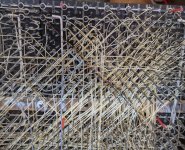Not sure if this helps here:
When I worked in DEC Fieldservice and had to find a short in a 11/70 Backplane between two Signals
I connected a continuity beeper to one signal
Then I stacked two extender boards and runned the second probe slowly over the extender traces until it beeped
This had to be done for all suspected slots
So I could work out all connections to a specific signal and then look closely what wirewrap pin did cut through the insulation of a tense wire
Today you could eventually run some limited current through the suspect wire and use a thermal camera to see the path in a crowded backplane
For jumper wires: a female Berg connector pin crimped to a wire should do the job
When I worked in DEC Fieldservice and had to find a short in a 11/70 Backplane between two Signals
I connected a continuity beeper to one signal
Then I stacked two extender boards and runned the second probe slowly over the extender traces until it beeped
This had to be done for all suspected slots
So I could work out all connections to a specific signal and then look closely what wirewrap pin did cut through the insulation of a tense wire
Today you could eventually run some limited current through the suspect wire and use a thermal camera to see the path in a crowded backplane
For jumper wires: a female Berg connector pin crimped to a wire should do the job

